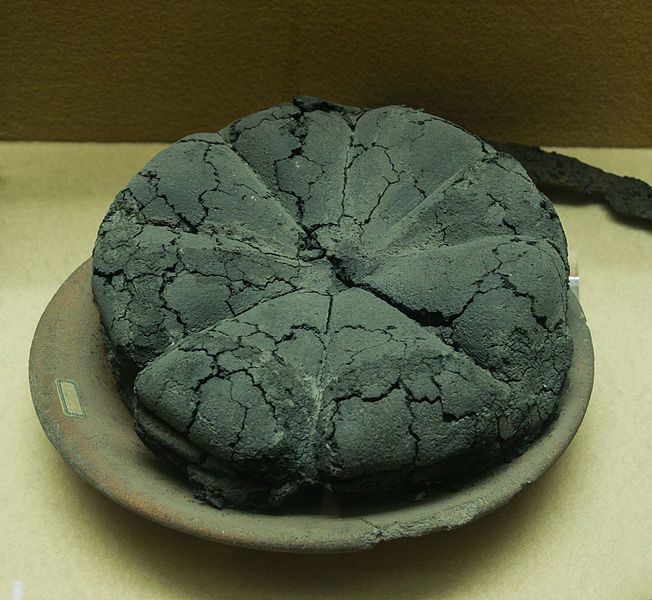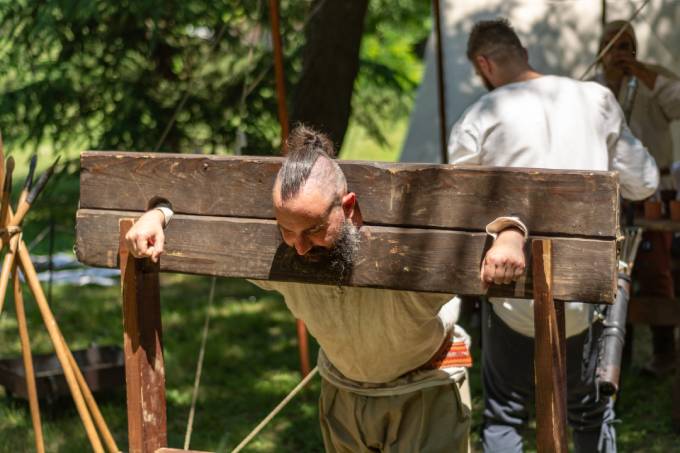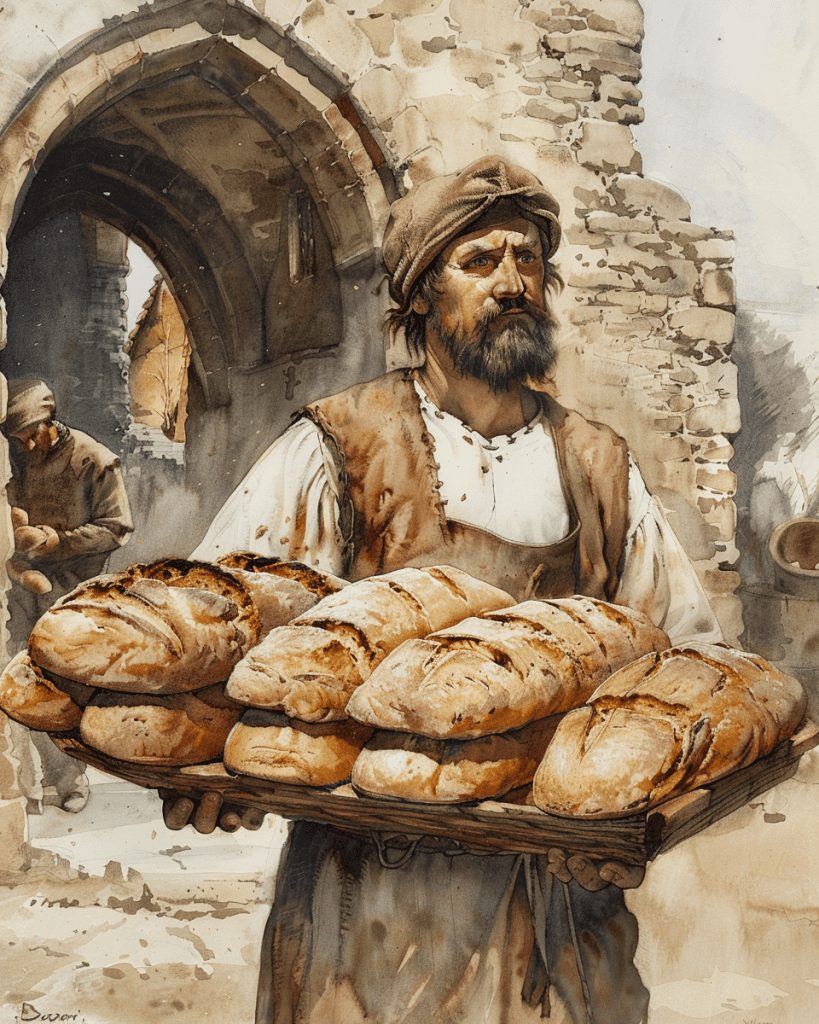As the last glaciers retreated, neolithic humans went through a scientific revolution. The temperature rose, and civilizations throughout the world began mastering both plants and animals.
It doesn’t matter which came first, the domesticated kitten or the wheat silo (likely a symbiotic relationship), but humans could be finally free of starvation. We were increasingly growing, engineering, and feeding ourselves with grains instead of being interested in hunting or gathering.
An army marches on its stomach
Gradually, we got better at mass producing foods and one of the first, based on archaeological evidence, was bread. It was the life force of most city-dwellers, peasants, nomads, and soldiers alike.
Leaders from kings to lords put their best minds at the problems of supply lines and feeding an ever-increasing population. They developed iron plows, used draft animals for mechanical dough-mixing, and hired countless supports like brick-makers and woodcutters to produce enormous rations as far back as 3000 BCE.
Old-school fakin’ bakin’
Most small settlements had at least one baker by the Roman Republic, whereas large cities might have dozens. Although military contracts by state leaders to produce bread had kept quality control for the fighting men, commercial practices for average customers went virtually ungoverned.
Gradually local laws were passed and rules for selling bread published to dissuade the usual dupes: adulterants and misrepresentation. People throughout history had added pebbles to the loaf for weight, rigged counting and measures, or simply used cheaper substitutes.
Bake it until you make it
The Roman Bakers Guild or Collegium Pistorum dates back to 169 CBE. It was created to protect baker interests and trade secrets. Roman bakers had perfected open-fire and oven-baked flatbreads, voluminous loaves, sourdough, and pastries of every kind. They specifically bonded to root out cheats and determine quality controls like weight standards and makers-marks. Several of the dozen or so loaves excavated at the burial site of Pompeii from 79 BCE bear these standards.

Sadly, for centuries, bakers could continue fleecing the masses in the rest of the world. Monopolies arose in small towns (think The Miller’s Tale), and guilds often colluded to inflate the price a customer might pay.
No pain, no grain: Origin and theory of the baker’s dozen
Price and quality standards wouldn’t appear again until the reign of King John of England. In 1202 he enacted a law to govern the measure of wheat, a standard of practice, and define a reasonable profit. Using Anglo-Saxon precedent one small loaf cost a penny, the same as one egg.
If you instead bought a shilling’s worth (the next denomination worth 12 pennies), you would be sold a dozen eggs or a dozen loaves, respectively. These are the origins of the phrases “Baker’s dozen” or “Long dozen” and, in theory, why we often group batches of 12 when selling commonly occurring, low-value items.
There were also new controls for weight which harshly punished anyone selling underweight loaves. Out of fear, as a hedge against error, most bakers began adding an extra loaf or two (thirteen or fourteen) as insurance for each dozen that came to be called a baker’s dozen.
Making extra dough: The Worshipful Company of Bakers in England
This collaborative group of London guilds and local lords were granted the responsibility of upholding the King’s standards. They were only too happy to see many bakers making insurance loaves with each batch.
They could take the thirteenth loaf in the baker’s dozen as an indirect tithe, bribe, or resell all thirteen loaves at full price. By decades end these baked goods were being sold as singles door-to-door to capitalize on this loophole.
Raise a toast to grain taxes
The guilds commonly worked in tandem with royal commissionaires from a board called the Assize of Bread to represent bakers and police wheat cheats. It specifically governed grain production and provided methods of counting, controlling, price setting, and taxing both bread and ale.
These standards and tariffs were gradually forced or adopted worldwide as empires were built, countries urbanized, and economies modernized. Sometimes these failed to quell excess entrepreneurial spirit, and bakers found themselves in the pillory posts, exiled, or witnessed the destruction of their former practice.

Your customers are always right: Witches can count to thirteen
There is a 17th-century story of an old woman that visited a bakery in colonial New York wishing to buy Christmas cookies. She ordered a dozen Saint Nicholas cookies and immediately questioned the quantity received. Other shops upheld the practice of giving baker’s dozens instead of only twelve, which the witch received from the guy behind the counter.
He told her that he could not afford to do business the way other bakers sold them. The baker had a large family, a dozen competitors, and intense competition for profit. She left without the cookies but not before putting a curse on the baker for his greed. Oral tradition tells of a newcomer Dutch baker from the Stuart period who lost his business in Albany on account of witchcraft, retelling the story of a baker’s dozen cut short.
The apex of adulteration
Technology from the Industrial Revolution changed everything from mechanized planting, harvesting, grinding, sifting, dough-making and baking. The process of making bread had changed but was still governed by archaic English legal standards.
It was far more difficult to test among tens of thousands of uniformly produced loaves to ensure quality. So why not add plaster of Paris, bean flour, alum, chalk, or Borax instead? This white-washing continued into the 20th century when laws were finally updated to protect consumers.
The upper-crust of our civilization or a dime a dozen?
Bread kindled our civilization, feeds the present, and will fuel our future. Along with other staple grains, it allowed us to develop and prosper as a species. Pity though, its makers had such bad reputations as cheats or scoundrels in the past. Then again, wasn’t a bakery on Pudding Lane the source of the Great Fire of 1666? Or used phrases like “peace, land, and bread” to ferment revolution?

